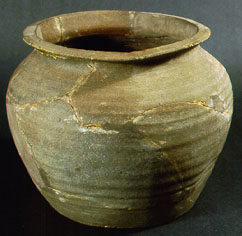| Fingerprints of the maker |
| The making of the vessel | |
| The manufacturing processes were complex and each stage presented a design choice. Vessels thrown on a wheel have the potential to be more symmetrical than if handmade. Handles and spouts often reflect the personal technique of an individual potter. Following its abandonment at the end of the Roman period, the potter's wheel was reintroduced from the eighth century onwards enabling the potters to meet the needs of the growing urban communities. As late as the nineteenth century, however, some country potters continued to build their pots by hand. |

A rounded wheel-thrown jar or waster (an overfired vessel) from a kiln excavated at Brill, in Buckinghamshire |
| Why did they adapt the clay? | Fingerprints ... | Decorative techniques |
|
© Copyright University of Oxford, Ashmolean Museum, 2000 The Ashmolean Museum retains the copyright of all materials used here and in its Museum Web pages. last updated: jcm/27-jun-2000 |